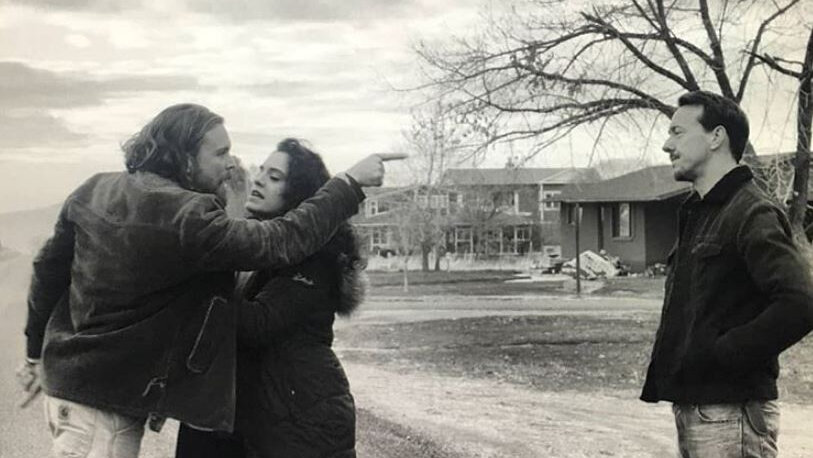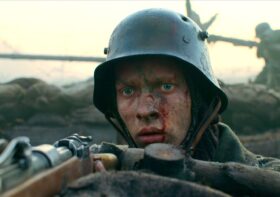The Killing Of Two Lovers: A Painful Depiction Of The Fractured Male Psyche

I’m hard-pressed to think of a recent film that’s introduction gripped me as much as the first sixty seconds of Robert Machoian’s The Killing of Two Lovers. The first shot is a relatively simple one: a close-up of our protagonist David’s pained expression (expertly played by a thoughtfully restrained Clayne Crawford.) It’s only when Machoian chooses to cut to a reverse angle that the whole image becomes clear. David stands over a couple in bed, both sleeping away the hours of the wee morning. It’s a creepy image for anyone, but it’s what is revealed next that makes the entire scene unsettling for even the strongest of hearts: David holds a gun above the pair of sleeping lovers. As David contemplates taking the lives of these two (and as we cling onto every frame with pure dread and unease), a noise comes from outside of the room. Quiet enough to keep the two lovers sound asleep but loud enough to tell David to get the hell out of there before he can cause any actual harm.
It’s an intro that demands our attention and, luckily for us, is followed by an 80-minute duration that holds onto it. Shot on grainy 16mm film, The Killing of Two Lovers follows the downfall spiral of David, a failed musician and farmhand doing everything he can to keep his family and marriage from falling apart during an amicable break with his wife Nikki (played here by a carefully placed Sepideh Moafi.) With the entirety of the movie taking place in David and Nikki’s tiny, run-down town (hell, David’s still in walking distance of his kids as he takes part-time residence in his father’s home down the street), there’s a crippling sense of poetic dread that the derelict and setting gives off. This seemingly placid location where everybody knows everybody somehow makes David’s conundrum all the more worse as there isn’t a secret anyone can hide, and no relationship is left truly sacred or intimate.
The Killing of Two Lovers is David’s story and David’s alone. Trapped in a claustrophobic 4:3 aspect ratio, David is the primary focal point of close to every shot of the film, forcing us to experience every awkward encounter, every close-call, and worst of all, every heartbreak our protagonist experiences. What makes the entire film such a never-racking experience is that it can be likened to watching an intoxicated circus performer walking across a tightrope as thin as floss. David’s impulsive, driven entirely by emotion without any logic or reason behind his actions or decisions. And as the film progresses, we’re forced to ask ourselves if there’s any sanity left within David’s mind. Or if there was any at all when we first met him. It’s a tricky character to nail down. Still, Crawford makes it clear that he’s more than up to the task, instilling David with a distinct sense of humanity we can’t help but relate to and root for even when we know his malicious intent (a tactic Crawford pulled off with equal precision and success in the short-lived television show Rectify.)
While David covers the most screentime out of the limited ensemble, he is never alone when he’s the only figure in the frame. To anchor David’s fractured psyche is the film’s haunting and volatile sound design. As prominent of a character as David and Nikki, the sound design consists primarily of sudden screeches and bangs akin to the sound of a truck door slamming shut. The unexpected sounds throw the viewer around like a rag doll, leaving them disorientated and grasping for some sort of clarity, much like our tortured protagonist. What could have easily derailed the entire picture into forced melodrama ends up only enhancing the crippling sense of dread that lingers over the course of the whole film.
With a full-throttle pace so lean and streamlined, it was a bit jolting when the film rushed to its inevitable conclusion. Throughout the film’s slim 80-minute runtime, we endure the same subtle pain and torment that David does. Nothing is flashy or over-the-top. Nothing too combative or confrontational. Just a typical blue-collared family man reckoning with the possibility that he may not have a family once everything is said and done. With every long-lasting close-up or lingering shot, we as the audience, become just as concerned about our central family as David is. This is why when we’re given shoehorned ending, we can’t help but feel a bit underwhelmed. While we’re given a definitive answer of whether or David’s entire world will crumble, nothing feels earned. Nothing feels special. Over the course of an hour and twenty minutes, we’re forced to watch David do everything in his power to keep his family intact and get his wife back, but with an ending that seemed essentially tacked on as an afterthought, he might have been best doing nothing and just waited for the film’s inevitable conclusion. Nothing that David does as a character makes any actual impact on the outcome of the film, and thus, no impact on the outcome of his marriage.
While some may find the title of the film to be a bit misleading (this is by no means a revenge tale), The Killer Of Two Lovers is nonetheless one of the most impactful character studies to come around in a long time. Thought-provoking and gut-wrenching in equal doses while shining a bright spotlight on the humanity of small-town America, The Killing Of Two Lovers is always enthralling and will linger with you long after the credits have rolled.


Leave a Reply